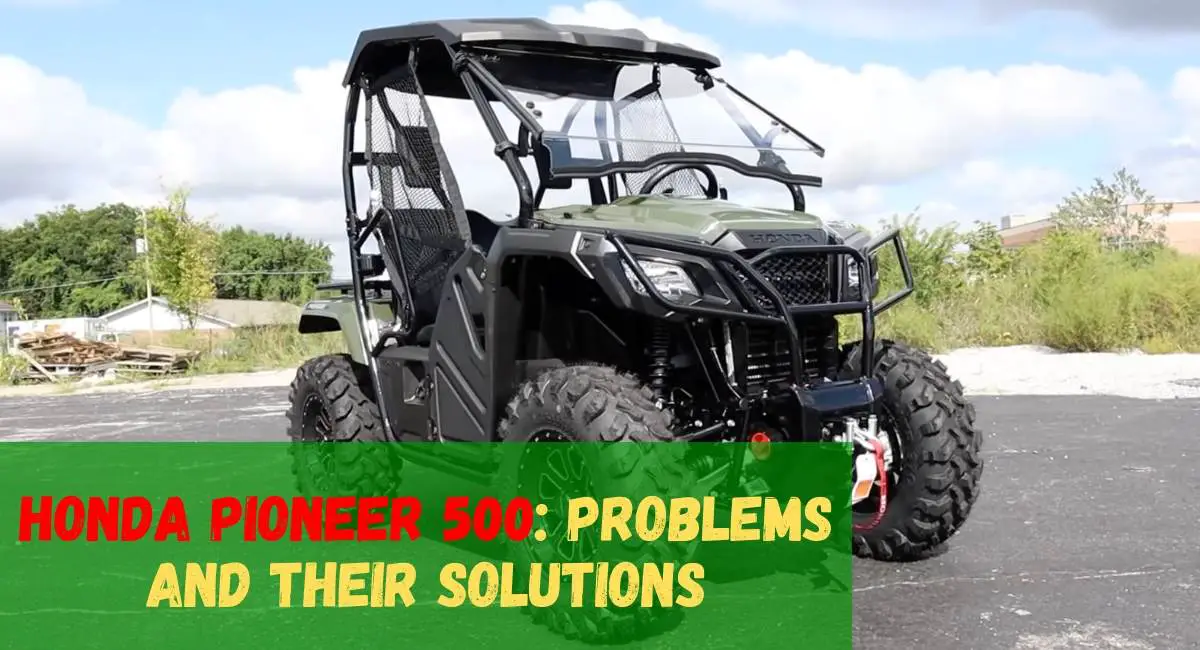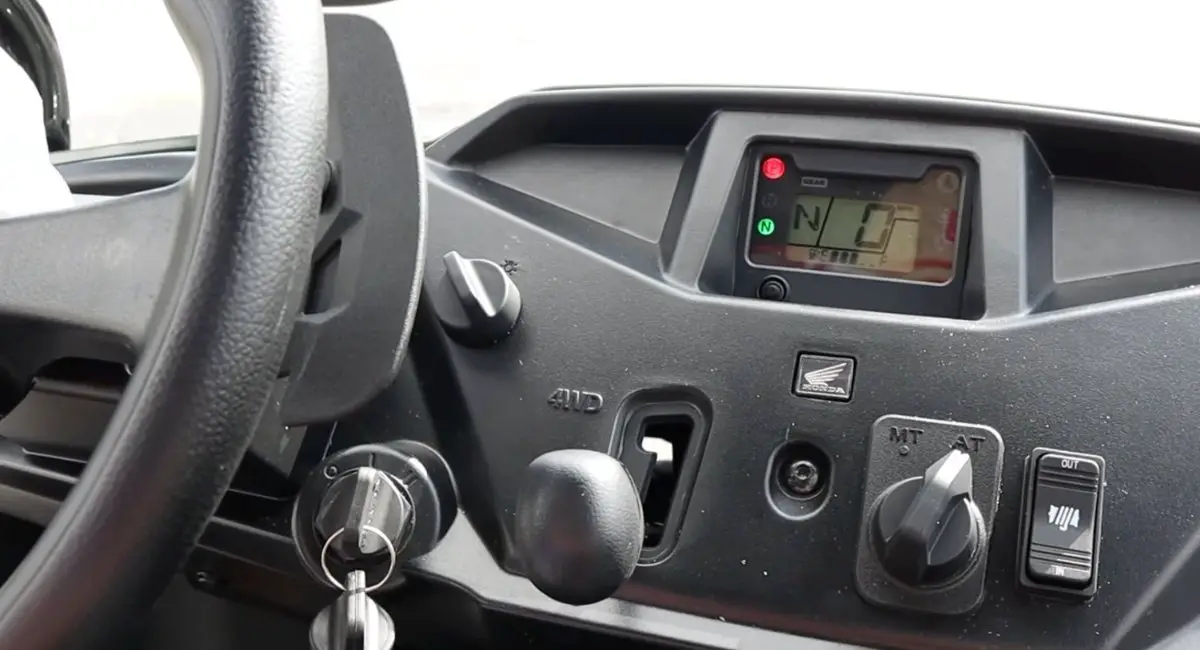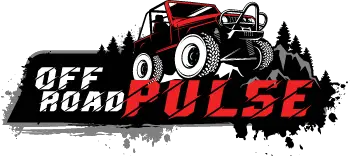The Honda Pioneer 500 is undoubtedly the ultimate outdoor machine that gets the job done. Apart from riding for fun, Pioneer 500 is capable of all kinds of jobs, including touring the farm, hunting, or just recreational uses. With this Honda machine, you’re guaranteed a compact, affordable, and fun UTV that will allow you to explore even the toughest trails.
The best part yet, you can upgrade your machine with plenty of aftermarket accessories from Honda and other compatible brands. However, like any other vehicle, the Pioneer 500 is not foolproof, and you are bound to experience a couple of problems now and then.
Although regular maintenance helps to keep most of these problems in check, it is not uncommon for this UTV to fail to start. Other problems include general engine wear and tear, transmission problems and shifting problems, just to mention a few.
But before we discuss the ten common Honda Pioneer problems and their solutions in detail, here is what you need to know about this side-by-side Honda machine.
Honda Pioneer 500 Specifications
- Engine type- 475cc single-cylinder
- Transmission- 5 Speed automatic + reverse
- Seating capacity- 2
- Dimensions- 102.6”(L) 50”(W) 71.3”(H)
- Seat height- 27.7”
- Horsepower- 28.6 HP
- Top speed- 40 MPH
- Tire size- 24”x8”x12” (front) 24”x10”x12” (rear)
- Wheelbase- 73.0”
- Fuel capacity- 4.1 gal.
- Turning radius- 12.8 ft.
- Ground clearance- 8.5”
- Towing capacity- 1,000 lbs.
- Cargo rack capacity- 450 lbs.

Honda Pioneer 500 top features and benefits
Fully automatic transmission- Pioneer 500 comes with a fully automatic transmission system. The primary advantage is that the user rests assured that the automatic transmission will take care of their shifting needs hassle-free.
Powerful fuel-injected engine- This UTV comes with a high-efficiency fuel-injected engine, a design that helps provide optimal engine performance and great fuel efficiency. So, if you’re looking for a machine that runs smoothly without putting in a lot of work, then the Pioneer 500 is your best bet.
Narrow body- Measuring barely 50 inches wide, the Pioneer 500 is narrow than a typical passenger vehicle, making it suitable for tight spaces or width-limited trails/construction sites. Simply put, this UTV will go just about where no other machine can.
Side-by-side seating- As the name suggests, this UTV boasts a comfortable side-by-side seating arrangement. The Pioneer 500 is equipped with individual seatbelts and backrests to ensure optimal comfort for both the rider and the passenger.
Compact chassis- With a wheelbase of up to 73.1-inch, the Pioneer 500 benefits from a compact and rigid chassis which helps improve ground clearance and facilitate a tight turning radius .
Liquid-cooled engine- The Honda Pioneer 500 utilizes a tested and liquid-cooled engine that provides not only more power but also cooler and consistent operating temperatures. On top of that, liquid cooling helps to reduce engine vibrations, which contributes to better performance and extended service life.
Hydraulic disc brakes (both front and rear gears) – The hydraulic braking system offer finer control meaning you can brake confidently. This braking system also ensures responsive handling, thereby making the UTV fun to drive.
Single access for door/net – This machine is fitted with standard doors and a net that is directly attached to the door. With the twist action knob, you can open the door and the UTV net as one unit, thereby facilitating a straightforward entry and exit.
Independent Rear Suspension- The Pioneer 500 uses a fully independent rear suspension (IRS) meaning it offers great traction, especially when riding on tough terrains. The result of this is an exceptionally smooth ride.
Honda Pioneer 500 Problems
Although there are quite a few cases of Pioneer 500 problems reported, it is not uncommon to run into issues while using your utility task vehicle. Whether it is something minor as noisy components or serious problems with the transmission system, or a dead battery, a lot can go wrong with this UTV.
As such, it is critical you learn some of the most common Pioneer 500 problems considering that some of these issues can be a deal breaker. Having said, here are the top ten common problems you may encounter with Honda Pioneer 500 and their solutions.

1. Starting issues
There is nothing as frustrating as getting ready to cruise through sand dunes only to realize that your Honda Pioneer 500 won’t start. This means that instead of getting your adrenaline pumping up the trails, you’ll now need to focus all your energy on trying to find out what could be wrong with your machine. Some of the common reasons why your machine may fail to start include;
- Dead battery
- Activated kill switch
- Depleted fuel
- Damaged spark plug
- Insufficient airflow
Solutions
If you suspect any of the above is the reason machine you’ll need to get it diagnosed and fix the underlying condition as soon as possible. The best thing is that most of these issues are relatively easy and inexpensive to fix. However, if you don’t have prior experience with an off-road machine it is always a good idea to take it to a skilled mechanic to help fix any issue.
That said, always ensure that the kill switch is in on the on/run position before you start your machine. In addition, be sure to check your battery level and recharge as needed. If your battery is completely worn out, consider getting a replacement. Also, ensure to refill your fuel tank before you take on the trails.
Other basic maintenance practices that will help keep your UTV in tip-top shape include cleaning/ replacing the spark plug and the air filter. To be on the safe side, always ensure to learn the best way to clean or replace these components.
2. Honda Pioneer 500 transmission problems
If your transmission has a mechanical issue or is not tuned properly, then you’re bound to run into trouble. Identifying transmission issues early enough can help prevent costly repairs and prevent further damage to our machine. Some of the symptoms that could indicate that there is an issue with your machine’s transmission include;
- Annoying grinding noise/ unusual sounds
- Failing to engage the gear
- A jerky acceleration
- Leaking fluid
- Check engine light
Solutions
Performing basic maintenance on your Honda transmission, will keep it from malfunctioning and wearing out. Such includes inspecting the condition of your transmission before riding and changing your transmission fluid often. If you’re dealing with a serious mechanical problem with your transmission system, it is always a good idea to seek the services of an expert.
3. Honda Pioneer 500 shifting problems
Apart from transmission issues, most Honda Pioneer 500 users complain about a range of gear-shifting issues, including failing to go into gear, grinding, popping out of gear, etc. It can be a stressful experience when you try to shift your four-wheeler gear but won’t move a dime.
There are a couple of reasons for Pioneer 500 shifting issues, but the primary ones are a faulty gear shifting mechanism, an issue with the braking system, a damaged driveline/drive belt, and issues within the transmission system.
Solutions
To troubleshoot shifting issues, you can start by inspecting the clutch for corrosion or any signs of damage. Also, ensure to check the braking system and if any part is broken or damaged, replace it immediately to get your machine moving again. If you’re using a manual clutch, ensure it is adjusted properly.
In addition, ensure to check your transmission system to see if it’s the one causing the gear problems. If you have done all this, but the shifting issues persist, consider towing your machine to a mechanic shop for a proper diagnosis.
4. Loss of power
There are many reasons why your Pioneer 500 may bog down while in the field or every time you take it out to spin. Insufficient engine power is often as a result of engine-related issues, but it could also be caused by several factors, including insufficient fuel, dead/worn-out battery clogged air filters, faulty spark plug/ ignition coil, etc.
For instance, a faulty ignition coil will struggle to transmit power to the spark plug, and in return, it might make your machine lose power. Similarly, burned or corroded spark plugs are yet another reason that can bog your machine down.
Solutions
Check the condition of your battery if it is severely damaged or worn out, the only solution to this is getting a replacement. Also ensure to check any broken engine part, including the spark plug, ignition coil, and air filter.
If you notice any sign of damage, the components will most likely need a replacement. Replacing engine parts is relatively complicated and risky so avoid attempting such at home. As such, you may want to consult your local mechanic for these kinds of repairs.
5. Oil and coolant problems
The primary purpose of oil is to lubricate the engine and minimize wear. On the other hand, a coolant helps to maintain optimal engine temperature, thereby preventing it from overheating. Although there might be a slight variance in oil and coolant levels from time to time, extreme variation can wreck the engine’s performance.
Apart from low oil level, dirty oil or over-used oil can make your machine runs into serious problems. Some of the symptoms of insufficient or dirty oil include a noisier engine, a ticking noise whenever you start the engine, wobbling, lower gas mileage, and overall poor engine performance.
Solutions
When you begin to notice the oil getting darker or some unusual noise from the engine, your UTV is trying to tell you that something is wrong with your oil. For these reasons, make a point to check your oil and coolant levels, and ensure that they are topped up before every ride.
In addition, ensure to inspect your machine for possible oil leaks. If the oil is below the recommended level consider topping up as soon as possible. Furthermore, ensure to check the user manual for the recommended oil types and the changing interval.
6. Battery problems
Riding your machine with a worn-out battery or one that keeps draining can be really frustrating. Waking up to a completely dead battery can also be an inconvenience, especially when you have urgent needs you need to attend to.
If your machine’s battery has run out of charge or is completely worn out, the engine won’t start, plus it also compromises other major functions. Unfortunately, battery issues are quite common among Pioneer 500 users, but luckily most are fairly easy to fix.
Solutions
Depending on the severity of the matter, there are a couple of troubleshooting measures you can undertake to help fix various battery issues. For instance, make sure to recharge your battery once you suspect it might be running out of charge.
Additionally, ensure to check the battery fluid level and refill as needed. If the battery is beyond repair consider discarding it and replacing it with a new one. If the problems don’t go after even after doing all these, consider getting the battery checked by a professional.
7. Tire problems
Much like any other vehicle, Pioneer 500 tires are not designed to last forever. As such, it is important to understand what to look out for when it comes to your machine’s tires. Some of the first signs that your tires might be having a problem include unusual wobbling or vibration when riding and weird sounds especially when you change your speed.
If you notice any unusual thing with one all your tires, it could be an indication of a flat spot, low pressure, or another deep-rooted problem. As such, it is important to address any tire issue before it gets you into deep trouble.
Solutions
Riding on bad tires can be quite dangerous plus they can compromise your traction control. As such, ensure to inspect your tire before riding to help identify and rectify minor issues before they escalate. If the tires are completely worn-out consider replacing them with new ones to avoid damaging other wheel components. In addition, proper care and maintenance will go a long way in maximizing the life of your tires and improving your UTV performance
8. Radiator problems
The work of the radiator is to keep your machine’s engine from overheating. If your radiator is faulty or not functioning well, it can make your machine run into all kinds of problems. Some of the signs of a bad or failing radiator in the Honda Pioneer 500 include;
- Overheating
- Low coolant level
- Discolored coolant/stained radiator
- The machine leaking coolant fluid
Solutions
If you see any of these signs, it means there is something wrong with your radiator. Keeping the radiator in optimal condition is critical to your machine’s overall performance. As such, you may want to bring your machine to an authorized mechanic to address the problem as soon as possible. In addition, always ensure that the radiator you purchase for your Honda Pioneer 500 is genuine.
9. Differential lock problems
Another probable but rare problem experienced by Pioneer 500 owners is the differential lock failing to engage. Ideally, the work of the differential lock is to help the wheels to spin at a similar speed, thereby improving the traction. If the lock is faulty, it can cause one or more wheels to fail to engage, leaving you vulnerable while riding. In addition, it might also make your machine sit still when changing gears or when you hit the throttle.
Solutions
Visually inspect the lock for any signs of damage or wearing. You may also want to check if dirt, water, or any other foreign objects have entered the lock, thereby interfering with its operation. Troubleshooting differential lock problems is a complex task, so we recommend you bring your machine to a trained mechanic to help diagnose and fix the issue and get you back on the trail as soon as possible.
10. Wiring issues
Wiring problems are not widely reported, but it is not uncommon to find some Honda Pioneer 500 owners experiencing some wiring issues. If your machine doesn’t start or tends to lose power occasionally, then the problem is most likely rooted in your wiring. If you suspect any electrical wiring problem, it is critical to turn off the machine and examine the root cause as soon as possible.
Solutions
Wiring issues can arise from simple things such as loose battery leads or wiring mistakes during the installation of key components. You can start by inspecting your entire wiring and if you determine it is loose, tighten it, and you’re good to go. Inspecting your machine will also help you check if the wires have become exposed or damaged.
Conclusion
Hopefully, this guide has helped you understand the most common Honda Pioneer 500 problems and made it easy to diagnose any mishap with your machine. Ignoring some of these tale-tell signs can cause irreversible problems down the road or lengthy and costly repairs.
The good thing is that for most of these problems, there is always a solution on how to troubleshoot your machine and a couple of mitigation measures. In addition, with regular and seasonal maintenance, you can help minimize some of these issues and extend the life of your UTV.




![How to Keep Mud from Sticking to UTV [Proper Guide] How to Keep Mud from Sticking to UTV](https://offroadpulse.com/wp-content/uploads/2022/09/Problem-with-Mud-for-utv.jpg)